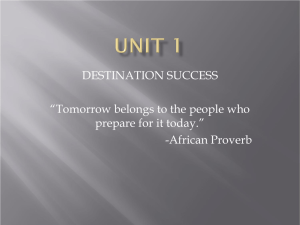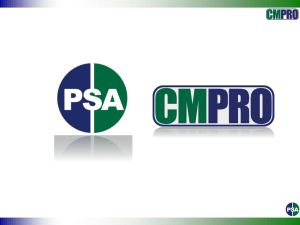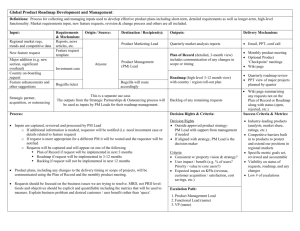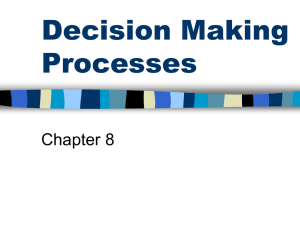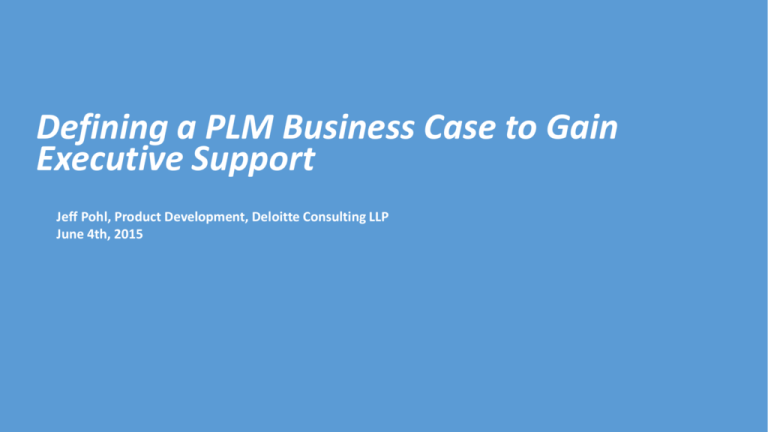
Defining a PLM Business Case to Gain
Executive Support
Jeff Pohl, Product Development, Deloitte Consulting LLP
June 4th, 2015
Deloitte’s Lean Engineering & PLM Services
Deloitte Consulting offers 360º services to address our clients’ strategic and operational challenges in
product development
Our Services
Our Tools & Accelerators
Major challenges facing the industry
Major challenges
Declining Engineering
Budgets
Limited Engineering
capacity
Increasing
complexity in
Engineering
Multiple interface
integrations
Unstable input and
shifting time frames
Factors
• R&D spend as a percentage of revenue has been falling this decade after consistent growth in
the last century
• Executives question the return on their investments from engineering organizations
• Engineering capacity requirements continues to grow across industries, e.g. Aerospace,
Automotive, etc.
• Required engineering skills for new processes and tools not available
• Deeply skilled Engineers are retiring and new talent is hard to find
• Increased leverage of external service providers
• Increasing amount of electronics and software
• Shorter lead times and development cycles
• Focus on innovation with new technologies, materials, etc
• Growing network of interactions with internal and external parties (customers, partners,
suppliers, matrix organization)
• Concurrent development programs and a Lack of early cross-functional involvement
• Delay of input data from customer e.g. product definition
• Shifting schedules from program partners
• Increasing complexity of interactions with Manufacturing
Our Lean Engineering transformation capabilities have proven to be effective for a wide
spectrum of clients with varying product complexity
Highly Engineered
Products and
Construction
Engineered to Order
Products
Configured to Order
Products
GE Power Plant
Bell Helicopter
Caterpillar
Westinghouse
Nuclear
SpiritAero Systems
Nissan
GE Turbines
JCI Auto Interiors
Cobham
Pratt and Whitney
Canada
Lockheed Space
Marvin Engineering
Build to Stock
Products
Vitamix (Kitchen
Appliances)
MTD (Lawn Mowers
and Garden Equips)
Revlon
Coke
Monster Cable
Our Lean Engineering transformation approach focuses on addressing gaps in Process,
Technology, and Org Design to free up between 15-30% engineering capacity
The Assessment Phase
The Assessment quickly identifies the areas most critical to improving performance
Change
Imperative
Finalize
Scope
Deploy
Weeks
Months, Not Years
Assess
Identify the critical areas for improving
performance and develop roadmap
Improve
Define and deploy specific improvements across
people, process and technology
Engineering
Strategy
Improve the engineering strategy and operating model; innovation and
growth strategy
Operational
Excellence
Lean business processes and aligned roles, and responsibilities across
product areas and functions
Organization
and Talent
Bolster the operational structure, governance, competencies, skills, and
talent
PLM
Technology
Improve quality and traceability of information. Integrate execution to
improve flow across silos
Our transformation approach has helped numerous clients reduce time-to-market,
improve engineering efficiency, and increase profitability
Engineering Transformation Strategy Assessment
Our 6-12 week assessment involves a rapid but integrated assessment of engineering processes, tools,
organization and talent related barriers
Step 1
Vision & Objectives
Step 2
Assess Current State
Step 3
Define Future State
Step 4
Build Implementation
Roadmap and Business Case
Step 1: Future Vision & Objectives
Developing a business case requires a clear understanding of the overall vision, objectives and goals. A
Detailed vision and objectives form the foundation to guide the development of the roadmap and
supporting business case
Future state vision & objectives
Future Vision & Objectives
Use enterprise-wide systems to
strategically drive global common
business processes using global
common data
Lean Eng Project Objectives
The Lean Engineering Assessment project shall achieve the following
goals :
• Significantly improve the effectiveness and efficiency of
engineering capabilities
• Strengthen global delivery by integrating the core processes and
organization that is cost effective and caters to dynamics of
footprint and budget
• Accelerate development of skills and hiring plans based on
identified core competencies
• Provide the right information, at the right time, for the right people
• Integrate the extended enterprise’s information resources
Activities associated with this phase
Review the future vision, goals and objectives
Review project objectives and goals
Identify the projects, processes and data for the assessment
On-board resources to participate in the assessment
Deliverables
Deloitte’s perspective of the future vision and objectives
Select appropriate recent projects for value stream and capability
analyses
Step 2a: Assess Current State Capabilities
We evaluate the current state of each of the core capabilities, benchmark against best-in-class and identify
the root causes of inefficiency
20+ core capabilities identified with best-in-class assessment
Current state assessment for each
of the core capabilities
Future state maturity goal
Activities associated with this phase
Conduct current state assessment workshops and interviews to perform
qualitative process maturity assessment of core capabilities
Identify root cause of process inefficiencies
Deliverables
Core Capabilities - Current state qualitative assessment & future state maturity
goal
Step 2b: Engineering Efficiency (Quantitative)
The engineering churn analysis depicts the magnitude of “as is” inefficiencies
Engineering Efficiency Analytics
• Actual resource allocation and change data for
representative program(s) is used to determine the
magnitude of inefficiency in the current state
• A representative component or sub-system is
assessed using our Lean Value Stream mapping
tool to identify the root causes of inefficiencies
• Typically utilizing reconfigured processes can
reduce churn in development, and free up 10-20%
of the engineering capacity.
Activities associated with this phase
Identify projects and processes for the efficiency assessment
Collect actual data on exact electronic and physical flow of information during the
part’s design process
Conduct churn and manpower analysis
Generate value stream map and churn report to identify root causes of
engineering inefficiencies
Deliverables
Value stream maps and supporting analysis & Engineering churn analysis
Documented root causes of inefficiencies as identified by the value stream
mapping and churn analysis
Identify magnitude of inefficiency in the current state
Step 2b: We perform deep fact based analytics. One Example: Engineering Churn Analysis
Churn caused by unnecessary rework and change can be reduced through practical improvements to
engineering processes and tools. To understand the root cause of churn, engineering changes and resource
data need to be analyzed:
ILLUSTRATIVE
Managing Churn
• Typically, churn in core product development processes is caused
by limitations in:
• Management and planning
•
•
Design processes and disciplines
Design tools and systems
• Chief among these causes are unexpected content
growth and poorly coordinated or late design changes
• Churn can often be managed via adjustments to
existing processes and systems coupled with leadership
recognition of it as a major competitive issue
ILLUSTRATIVE
Engineering Resources
• Design resource consumption patterns can also reveal
churn (and quality risks) as designs are reworked to
completion
Step 2b: Another example is value stream analysis to depict Operational Complexity
Additionally, organizations need to employ a more rigorous value stream analysis technique to reveal work
configuration complexity in business processes. Reductions to operational complexity and cost are easily
visualized and quantified.
•
Numerous transactions/ hand-offs
•
Disjointed flow of information
change)
Plant (raising ECR
and implementing
Reques t to c hange
model is made
• Reconfiguration design involves:
•
Workflow changes
•
Policy changes
•
Organizational alignment
•
Physical work location
Drawings are
adjus ted, c hanges
are prototy ped, in
PRO-E and ECR
is s ubmitted to
Change Board
ECR is rev iewed,
approv ed and
c ategoriz ed
Engineer c hec k s
draw ings and
tak es c ategoriz ed
ECRs to mak e a
s ingle ECO
Begin determining
requirements and
potential effec tiv ity
dates for
implement the
ECO
Reply with date
new part/c hange
to part c an be
made by
Proprietary and Confidential
Value Stream Reconfiguration
ECR is written by
the manufac turing
engineer/quality
tec hnic ian
Change Board
Multiple dimensions of work
Appendix
To-Be Logical Process M ap: ECR/E CO Process
Engineer
•
Enterprise Operations Excellence
ECO Implementer
• Traditional process mapping masks the
actual behavior of the process
• Work configuration mapping reveals:
Supplier/Plant the
make changed part
Value Stream Mapping
Traditional View of Engineering
Workflow (10 Steps)
H andoff to the
res pons ible ECO
Implementer begin
the implementation
proc es s
Get appropriate
approv als
Releas e ECO
Set effec tiv ity date
and dis tribute ECO
15
Actual Workflow
(63 Steps)
Step 2c: Assess Current State - Software Development Assessment
Software Development Assessment will focus on the processes, practices and tools in place to partition,
develop, configure and release software, and the integration points to hardware
Software development lifecycle and
configuration management
Opportunities for incremental and transformative
improvements in core development
Hardware-Software
Integration
Software stacks, design
and reuse
Activities associated with this phase
Conduct a deep dive into SDLC and configuration mgmt processes
Evaluate the process for hardware-software integration
Evaluate the software framework and level of reuse
Identify root cause of process inefficiencies
Deliverables
Root cause of process inefficiencies
Opportunities for improvements
Step 2d: Assess Current State - Engineering IT Applications Assessment
Clear understanding of current technology landscape is important to drive the future state technology
transition plan – key to understand data flow and touch points.
Future state vision & goal
Future state technology roadmap
Phase - 1
Analyze future state vision and goal’s impact on
current state technology map.
Phase - 2
Final State
Analyze how the current state can be simplified future state
systems landscape by replacing multiple legacy PLM and
ALM systems with enterprise-wide standard tools.
Current implemented technology
Activities associated with this phase
Analyze the implemented technologies to create a clear
assessment of data flow and system touch points.
Determine & Document PLM Strategy
Map current tools used to manage the Engineering processes
Analyze the current tools landscape and recommend future state architecture
to accomplish desirable efficiencies
Identify root cause of process inefficiencies
Deliverables
Documented PLM vision, strategy, and objectives
Identification of PLM gaps/issues /risks in relation to how other companies
are successfully deploying PLM
Step 2e: Assess Current State - Organizational Structure and Talent Management
A clear understanding of the current organizational structure, governance, and the overall operating model
for product development leads to developing options for the future state. Balancing flexibility and efficiency
is critical in this exercise.
Competency/Skills
Competency/Skills
Governance
and leadership
Systems and
processes
Model Definitions
Model Role
Requirements
Competency/Skills
Model Gap
Assessment
Operating Model
Clearly
define roles
Organization
Performance
metrics
Strategy
Structure
Regional Model by
PBU
ET
Global Model by
PBU and OE
Vertical Global
Model by OE
Corporate
Corporate
Corporate
E&S
E&S
E&S
IDI
PT
ET
IDI
NA
LMS
Europe
ET
PT
IDI
PT
EOS
LMS
Competence
EOS
LMS
Vendors
Services
Vendors
PMO/HR
Regionalized
Competence
Activities associated with this phase
Assess the current competency models and broader talent
management strategy
Assess the organizational structure, decision making and
overall operating model
Deliverables
Gaps in competency and skills models, and talent
management
Pros/Cons of current structure vs. alternatives
PMO/HR
Vertically Aligned
Root causes of inefficiency and key improvement areas
Step 3: Define Future State
Based on vision, objectives and assessments define improvement initiatives, recommendations and future
state process/technology map to close the gap between as-is and to-be state.
The roadmap stages will be executed in parallel where feasible to
accelerate the implementation
Vision & Objectives
Master Implementation Roadmap
Months
Initiatives &
Recommendation
Stages
2
4
6
8
10
12
14
16
18
20
22
24
Use PDM 2.0
Stage Gate Process Go-Live
Stage 1: Common Stage Gate Process
Team 1
Use PDM 3.0 for design
Stage 2: Engineering & CAD
Documentation Standards, PDM
Requirements & Design
Common Engineering and CAD Documentation Standards Launched
Common PDM Design Ready
Team 2
Upgrade to/use PDM 3.0
BU 1
Go-Live
BU 2
Go-Live
Pilot
Implementation
Stage 3: PDM Implementation – BU1 ,
BU 2, BU 3
BU 3
Go-Live (legacy Phase-Out)
Team 3
Team 3
Team 3
Stage 4: PDM Implementation – BU 4
BU 5
Team 4
BU 4
Go-Live
PDM 3.0 date
Team 4
BU 5
Go-Live
PDM 4.0 date
© Deloitte Consulting 2002. All rights reserved.
Current State Assessments
17
Future State
Process,
Technology and
Organizational
Maps
Activities associated with this phase
Identify gaps based on value stream mapping and maturity assessment
Define recommendations to close identified gaps
Determine how to apply recommendations to key process and technology enablers
Deliverables
Prioritized recommendation list for process and PLM improvements
Future state concepts – Process, Technology and Organization
Step 4: Build Roadmap and Business Case
The assessment phase of the project culminates into a detailed roadmap and business case that identifies the
quantitative and qualitative benefits of the improvement initiatives.
Identify
• Identify Improvement
opportunities
• Define baseline for
improvement opportunities
Define & Validate
• Sequence improvement
benefits to roadmap
• Extrapolate benefits
across all programs
• Validate benefits with
Functional SMEs and
Stakeholders
Refine
Analyze
• Refine by comparing against
industry benchmarks
• Use conservative benchmarks to
leave potential upside
• Eliminate double counting and
refined benefit calculations with
feedback from functional SMEs
• Enter benefits into Financial
Impact Template to analyze
benefits and document
assumptions
• Determine ROI
Roadmap
Activities associated with this phase
Implementing redesigned development processes and PDM will
result in $62 million undiscounted cash inflow benefit and $28
million costs
$28 million
6-year cost
Quantify the business case benefits for each recommendation
Prioritize and sequence recommendations based upon dependencies and
value to the organization
$62 million
6-year
undiscounted
cash inflow
Financial Gains*
Implementation Costs
Software Training
Hardware Maintenance
Service Internal
Revenue
Revenue
Enhancement
Enhancement
Benefits
$16 million NPV
371% ROI
$103 million increase in profit
$32 million cost saving
$985 million increase in revenue
Cost
Cost Saving
Saving
Data
Reduced TTM Duplication
handling
Increased
Redundancy
development Info. Search Recall
Waste
capacity
Project
management Manu.
downtime
Operational Gains
21% reduction in NPD cycle time
6.5 employee redeployment over
six years
Finalize business case and validate with leadership and key stakeholders
Validate roadmap with leadership and key stakeholders
Deliverables
Business Case
Multi-phase roadmap
Executive presentation
Business Case
* Note: Calculations for a six year period
© Deloitte Consulting 2002. All rights reserved.
The roadmap provides a
multiyear plan to develop the
process, people, and
supporting infrastructure
required to achieve PLM vision
Costs and benefits of each
detailed recommendation are
calculated to determine the
total ROI
24
Q&A


